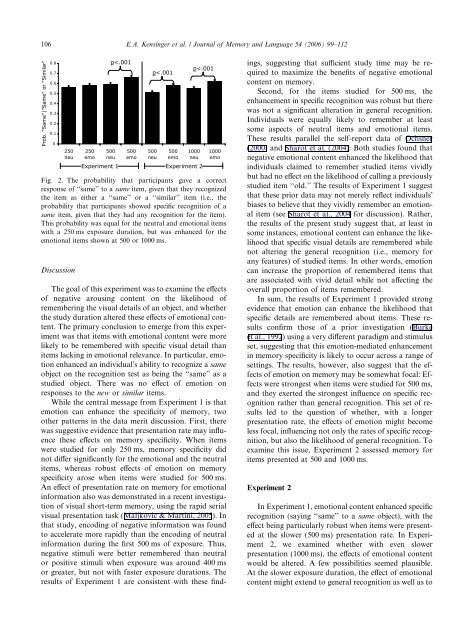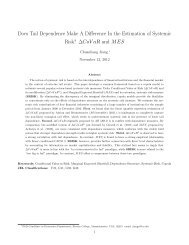Memory for specific visual details can be enhanced by negative ...
Memory for specific visual details can be enhanced by negative ...
Memory for specific visual details can be enhanced by negative ...
You also want an ePaper? Increase the reach of your titles
YUMPU automatically turns print PDFs into web optimized ePapers that Google loves.
106 E.A. Kensinger et al. / Journal of <strong>Memory</strong> and Language 54 (2006) 99–112<br />
Fig. 2. The probability that participants gave a correct<br />
response of ‘‘same’’ to a same item, given that they recognized<br />
the item as either a ‘‘same’’ or a ‘‘similar’’ item (i.e., the<br />
probability that participants showed <strong>specific</strong> recognition of a<br />
same item, given that they had any recognition <strong>for</strong> the item).<br />
This probability was equal <strong>for</strong> the neutral and emotional items<br />
with a 250 ms exposure duration, but was <strong>enhanced</strong> <strong>for</strong> the<br />
emotional items shown at 500 or 1000 ms.<br />
Discussion<br />
The goal of this experiment was to examine the effects<br />
of <strong>negative</strong> arousing content on the likelihood of<br />
remem<strong>be</strong>ring the <strong>visual</strong> <strong>details</strong> of an object, and whether<br />
the study duration altered these effects of emotional content.<br />
The primary conclusion to emerge from this experiment<br />
was that items with emotional content were more<br />
likely to <strong>be</strong> remem<strong>be</strong>red with <strong>specific</strong> <strong>visual</strong> detail than<br />
items lacking in emotional relevance. In particular, emotion<br />
<strong>enhanced</strong> an individualÕs ability to recognize a same<br />
object on the recognition test as <strong>be</strong>ing the ‘‘same’’ as a<br />
studied object. There was no effect of emotion on<br />
responses to the new or similar items.<br />
While the central message from Experiment 1 is that<br />
emotion <strong>can</strong> enhance the <strong>specific</strong>ity of memory, two<br />
other patterns in the data merit discussion. First, there<br />
was suggestive evidence that presentation rate may influence<br />
these effects on memory <strong>specific</strong>ity. When items<br />
were studied <strong>for</strong> only 250 ms, memory <strong>specific</strong>ity did<br />
not differ signifi<strong>can</strong>tly <strong>for</strong> the emotional and the neutral<br />
items, whereas robust effects of emotion on memory<br />
<strong>specific</strong>ity arose when items were studied <strong>for</strong> 500 ms.<br />
An effect of presentation rate on memory <strong>for</strong> emotional<br />
in<strong>for</strong>mation also was demonstrated in a recent investigation<br />
of <strong>visual</strong> short-term memory, using the rapid serial<br />
<strong>visual</strong> presentation task (Maljkovic & Martini, 2005). In<br />
that study, encoding of <strong>negative</strong> in<strong>for</strong>mation was found<br />
to accelerate more rapidly than the encoding of neutral<br />
in<strong>for</strong>mation during the first 500 ms of exposure. Thus,<br />
<strong>negative</strong> stimuli were <strong>be</strong>tter remem<strong>be</strong>red than neutral<br />
or positive stimuli when exposure was around 400 ms<br />
or greater, but not with faster exposure durations. The<br />
results of Experiment 1 are consistent with these findings,<br />
suggesting that sufficient study time may <strong>be</strong> required<br />
to maximize the <strong>be</strong>nefits of <strong>negative</strong> emotional<br />
content on memory.<br />
Second, <strong>for</strong> the items studied <strong>for</strong> 500 ms, the<br />
enhancement in <strong>specific</strong> recognition was robust but there<br />
was not a signifi<strong>can</strong>t alteration in general recognition.<br />
Individuals were equally likely to remem<strong>be</strong>r at least<br />
some aspects of neutral items and emotional items.<br />
These results parallel the self-report data of Ochsner<br />
(2000) and Sharot et al. (2004): Both studies found that<br />
<strong>negative</strong> emotional content <strong>enhanced</strong> the likelihood that<br />
individuals claimed to remem<strong>be</strong>r studied items vividly<br />
but had no effect on the likelihood of calling a previously<br />
studied item ‘‘old.’’ The results of Experiment 1 suggest<br />
that these prior data may not merely reflect individualsÕ<br />
biases to <strong>be</strong>lieve that they vividly remem<strong>be</strong>r an emotional<br />
item (see Sharot et al., 2004 <strong>for</strong> discussion). Rather,<br />
the results of the present study suggest that, at least in<br />
some instances, emotional content <strong>can</strong> enhance the likelihood<br />
that <strong>specific</strong> <strong>visual</strong> <strong>details</strong> are remem<strong>be</strong>red while<br />
not altering the general recognition (i.e., memory <strong>for</strong><br />
any features) of studied items. In other words, emotion<br />
<strong>can</strong> increase the proportion of remem<strong>be</strong>red items that<br />
are associated with vivid detail while not affecting the<br />
overall proportion of items remem<strong>be</strong>red.<br />
In sum, the results of Experiment 1 provided strong<br />
evidence that emotion <strong>can</strong> enhance the likelihood that<br />
<strong>specific</strong> <strong>details</strong> are remem<strong>be</strong>red about items. These results<br />
confirm those of a prior investigation (Burke<br />
et al., 1992) using a very different paradigm and stimulus<br />
set, suggesting that this emotion-mediated enhancement<br />
in memory <strong>specific</strong>ity is likely to occur across a range of<br />
settings. The results, however, also suggest that the effects<br />
of emotion on memory may <strong>be</strong> somewhat focal: Effects<br />
were strongest when items were studied <strong>for</strong> 500 ms,<br />
and they exerted the strongest influence on <strong>specific</strong> recognition<br />
rather than general recognition. This set of results<br />
led to the question of whether, with a longer<br />
presentation rate, the effects of emotion might <strong>be</strong>come<br />
less focal, influencing not only the rates of <strong>specific</strong> recognition,<br />
but also the likelihood of general recognition. To<br />
examine this issue, Experiment 2 assessed memory <strong>for</strong><br />
items presented at 500 and 1000 ms.<br />
Experiment 2<br />
In Experiment 1, emotional content <strong>enhanced</strong> <strong>specific</strong><br />
recognition (saying ‘‘same’’ to a same object), with the<br />
effect <strong>be</strong>ing particularly robust when items were presented<br />
at the slower (500 ms) presentation rate. In Experiment<br />
2, we examined whether with even slower<br />
presentation (1000 ms), the effects of emotional content<br />
would <strong>be</strong> altered. A few possibilities seemed plausible.<br />
At the slower exposure duration, the effect of emotional<br />
content might extend to general recognition as well as to

















